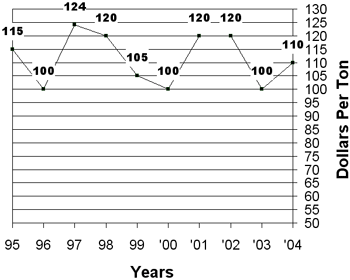Production Update:
Relative Feed Value (RFV): Relative feed value (RFV) is a calculated index of forage quality that is very useful in comparing different types of forages. RFV provides an indication of digestibility of a forage as does total digestible nutrients (TDN), but also includes intake potential. RFV is calculated from both ADF and NDF, whereas TDN is calculated from ADF only.
Insect Management: Several species of Empoasca
leafhoppers (picture)
occur in alfalfa. Adult leafhoppers are about 1/8” long, bright
green, wedge shaped bodies. Nymphs have green wedge-shaped bodies and
run rapidly forward, backward or from side to side when disturbed. In
the low desert, damage may occur from May through September. Symptoms
include a yellow, wedge-shaped area (
picture) at the tip of the leaf and stunting. With the first sign
of injury, sample the field with a standard sweep net taking 10 sweeps
in 4 to 6 areas over the entire field and count the adults and nymphs.
When an alfalfa field is 2 or more weeks from harvest, treat if counts
reach 5 leafhoppers per sweep. If alfalfa is within 10 days to 2 weeks
of harvest, treat at 10 per sweep. If alfalfa is to be harvested in a
few days, early cutting will control leafhoppers. Leafhopper infestations
may be confined to the first 50 to 100 feet of the field margin. If this
is the case, treat only the field edges where high leafhopper counts of
treatable magnitude are found.
Weed Control: Established Bermudagrass (picture)
can be controlled with multiple applications of the highest rates of Select/Prisim
or Poast. One application will often result in suppression for 3-5 weeks
after which the grass will produce regrowth and need to be treated again.
| Market Summary | High |
Low |
Average |
Off grade |
| Past 2 Weeks | 120 |
90 |
110 |
65-90 |
| Last Year | 102 |
95 |
100 |
85-95 |
10 Year Summary (March 9, to March 22, 1995-2004):

Issued in furtherance of Cooperative Extension work, acts of May 8 and June 30, 1914, in cooperation with the U.S. Department of Agriculture, James A. Christenson, Director Cooperative Extension, College of Agriculture and Life Sciences, The University of Arizona.
The University of Arizona is an equal opportunity, affirmative action institution. The University does not discriminate on the basis of race, color, religion, sex, national origin, age, disability, veteran status, or sexual orientation in its programs and activities.
Any products, services, or organizations that are
mentioned, shown, or indirectly implied in this web document do not imply
endorsement by The University of Arizona.
Information provided by:
Barry Tickes, btickes@ag.arizona.edu Extension Agent, Yuma County
Michael Ottman, mottman@ag.arizona.edu Agronomy Specialist
College of Agriculture, The University of Arizona.
Eric Natwick, etnatwick@ucdavis.edu UCCE Imperial County - Farm Advisor
University of California, Davis, CA.
Forages: Crop Mgmt | Soil Mgmt | Irrigation | Alfalfa Reports | Insects | Diseases | Weeds | Pesticides
Home | Other Crops | Forages
For more Arizona Production Ag Information:
Home | Cotton | Veggies| Forages | Grains | Citrus | Crop x Crop | Insects | Diseases| Weeds | Pesticides | News | Weather | Research | Photos | Contacts | General Info. | Site Map
Copyright © 2001 University of Arizona,
College of Agriculture and Life Sciences
Webmaster: Al Fournier (fournier@ag.arizona.edu)